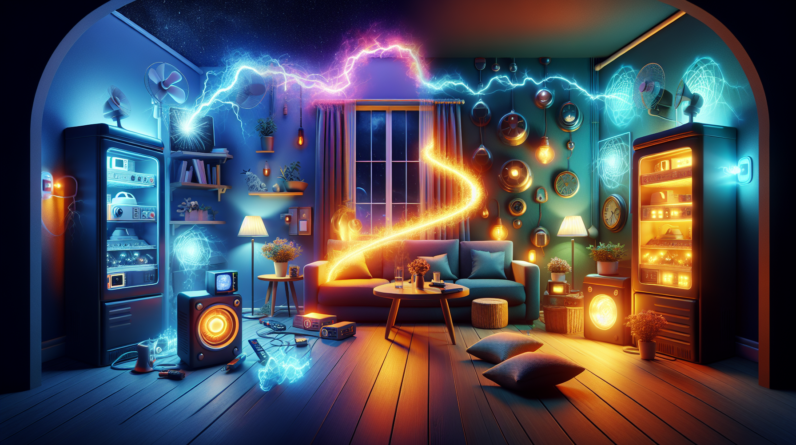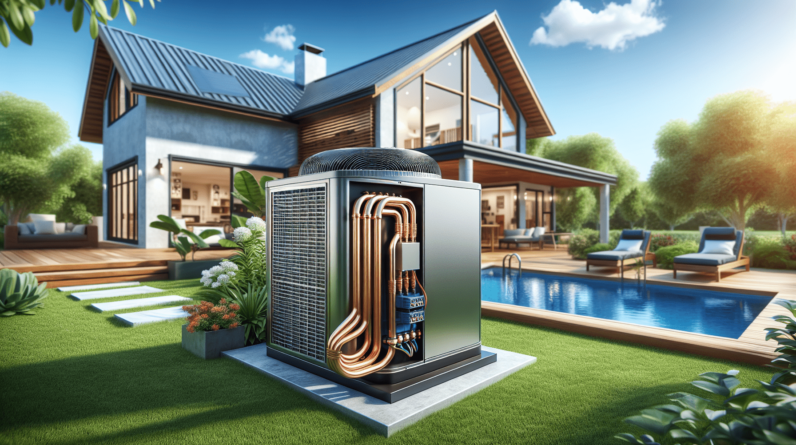

Have you ever experienced a sudden flickering of lights, followed by a complete blackout? Or maybe your electronic devices got fried after a thunderstorm? If so, chances are you have encountered a power surge or outage. In the world of electricity, these two common occurrences can cause quite a hassle. In this article, we will explore the definition, causes, and potential consequences of power surges and outages, helping you understand the importance of protecting your electrical devices.
Understanding Power Surges
Definition of a power surge
A power surge is a sudden increase in the voltage that flows through an electrical circuit. It can last for just a fraction of a second, but during that time, it can cause significant damage to electronic devices and appliances. Power surges can occur due to various factors, such as lightning strikes, faulty wiring, or the operation of high-powered electrical equipment. It’s important to understand that power surges can happen at any time and without warning, so it’s essential to take the necessary precautions to protect your electronic devices.
Causes of power surges
Power surges can have multiple causes. One common cause is a lightning strike near a power line. When lightning strikes, it can induce a power surge that travels through the electrical lines and can damage any connected devices. Additionally, the switching on or off of high-powered electrical devices, such as air conditioners or refrigerators, can also cause power surges. Faulty wiring and power grid issues are other potential causes of power surges. It’s important to be aware of these causes and take steps to minimize the risk of power surge damage.
Types of power surges
There are two main types of power surges: internal and external. Internal power surges, also known as transient voltages, are caused by the operation of electrical devices within your home or office. These surges can be generated by high-powered appliances like refrigerators or HVAC systems, or even by smaller devices like hairdryers or power tools. External power surges, on the other hand, are caused by factors outside of your control, such as lightning strikes, utility grid switching, or downed power lines. Both types of power surges can cause damage to your electronic devices if not properly protected.
Impact of power surges on electronics
Power surges can have a detrimental impact on electronic devices. When a power surge occurs, the excess voltage can overwhelm the delicate circuitry within your devices, causing them to malfunction or even completely fail. This can result in the loss of important data, damage to the internal components of the device, and the need for costly repairs or replacements. The impact of a power surge can be particularly severe for sensitive electronics like computers, TVs, and audio equipment. It’s crucial to protect your electronic devices from power surges to ensure their longevity and avoid unnecessary expenses.
Protecting Against Power Surges
Surge protectors
One of the most effective ways to protect your electronic devices from power surges is to use surge protectors. Surge protectors are devices that are designed to absorb and redirect excess voltage during a power surge. They typically feature multiple outlets and a built-in circuit breaker that cuts off power in the event of a surge. When choosing a surge protector, it’s important to select one with a high joule rating, as this determines how much energy the surge protector can handle. Additionally, surge protectors should be properly installed and regularly inspected to ensure their continued effectiveness.
Uninterruptible power supply (UPS)
An uninterruptible power supply (UPS) is another valuable tool for protecting your electronic devices from power surges. A UPS provides battery backup power in the event of a power outage and also acts as a surge protector. When a power surge occurs, the UPS will automatically switch to battery power, providing a consistent and clean source of energy to your connected devices. This not only protects against power surges but also allows you time to save your work and safely shut down your devices during an outage.
Power conditioning devices
In addition to surge protectors and UPSs, power conditioning devices can also help protect your electronic devices from power surges. These devices are designed to filter and stabilize the voltage that reaches your devices, ensuring a consistent and clean power supply. Power conditioners can help reduce the risk of damage caused by voltage fluctuations, electrical noise, and other power quality issues. They are particularly beneficial for audio and video equipment, which can be sensitive to these types of disturbances. By using power conditioning devices, you can enhance the performance and longevity of your electronic devices.
Dealing with Power Outages
Definition of a power outage
A power outage, also known as a blackout, is a complete or partial loss of electrical power in a specific area or building. Power outages can occur for a variety of reasons, including severe weather conditions, equipment failure, accidents, or scheduled maintenance. Whether the outage lasts for a few minutes or several days, it can have significant impacts on daily life, affecting everything from communication and transportation to food storage and medical care.
Causes of power outages
Power outages can be caused by a range of factors. Severe weather conditions, such as storms, hurricanes, or winter storms, are one of the most common causes of power outages. Strong winds, lightning, or heavy snow and ice can damage power lines, transformers, and other electrical infrastructure, leading to power failures. Equipment failure, including aging infrastructure or technical faults, can also result in power outages. Moreover, accidents, like vehicle collisions or construction mishaps, can disrupt the power supply.
Types of power outages
Power outages can be classified into two main types: planned and unplanned. Planned power outages, also known as scheduled outages, occur when the utility company deliberately shuts off power to a specific area or building for maintenance or repair purposes. These outages are typically announced in advance and are necessary for ensuring the safety and reliability of the electrical system. Unplanned power outages, on the other hand, are unexpected and often the result of external factors like severe weather, equipment failure, or accidents. These outages can occur without prior warning, leaving people and businesses without power.
Impact of power outages on daily life
Power outages can have a significant impact on daily life and can disrupt various aspects of our routines. Without electricity, many essential services become unavailable, making it difficult to communicate, cook, or navigate safely. Homes can become uncomfortable due to the lack of heating or cooling, and stored food can spoil without refrigeration. In businesses, power outages can lead to interruptions in productivity, loss of revenue, and potential damage to sensitive equipment. Additionally, power outages can disrupt medical services, transportation systems, and emergency response capabilities, further highlighting the importance of preparation and resilience.

Preparing for Power Outages
Emergency preparedness kit
To effectively manage power outages, it is crucial to be prepared. One of the first steps is to create an emergency preparedness kit. This kit should include essential items such as flashlights, batteries, a battery-powered radio, a first aid kit, non-perishable food, bottled water, and any necessary medications. Additionally, it’s important to keep a supply of warm blankets, extra clothing, and other items to ensure your comfort and safety during an outage. By having an emergency preparedness kit readily available, you can minimize the impact of a power outage and ensure your well-being.
Backup power sources
Having a backup power source is another effective strategy for dealing with power outages. Backup power sources can provide electricity when the main power supply is disrupted, allowing you to maintain essential functions. Generators are a popular choice for backup power as they can provide a reliable source of electricity. However, it’s essential to use generators safely and in accordance with the manufacturer’s instructions to avoid carbon monoxide poisoning or electrical hazards. Alternatively, battery-powered inverters or solar power systems can also serve as backup power sources, providing clean and sustainable energy during an outage.
Tips for managing during a power outage
During a power outage, it’s important to take certain measures to ensure your safety and make the situation more manageable. First and foremost, minimize the opening of refrigerators and freezers to preserve the cold temperatures inside and prevent food spoilage. Use flashlights or battery-powered lanterns instead of candles to avoid the risk of fire. If using a generator, place it outdoors in a well-ventilated area away from open windows and doors. Keep mobile devices charged and limit their use to conserve battery life. Finally, stay informed about the progress of power restoration efforts through local news sources or utility company updates.
Response to Power Outages
Power restoration process
When a power outage occurs, utility companies immediately begin the process of restoring power. The power restoration process involves a series of steps, starting with identifying the cause of the outage and locating the affected area. Once the problem is identified, repairs or replacements of damaged equipment are carried out. Utility crews work diligently to restore power as quickly and safely as possible. The restoration process may involve isolating damaged sections of the grid, rerouting power, or bringing in additional resources and personnel. The length of time it takes to restore power depends on the complexity and severity of the outage.
Roles of utility companies
Utility companies play a vital role in responding to power outages and managing the restoration process. These companies are responsible for the maintenance and operation of the electrical infrastructure, including power generation, transmission, and distribution systems. During a power outage, utility companies are responsible for assessing the situation, communicating with customers, and dispatching repair crews. They work closely with emergency management agencies, local authorities, and other stakeholders to ensure a coordinated and efficient response. Utility companies also play a crucial role in educating the public about power outage preparedness and safety measures.
Community response during power outages
In times of power outages, communities often come together to support each other and navigate through the challenges. Community response can include establishing local shelters or emergency centers to provide refuge and assistance to those affected by the outage. Community organizations and volunteers may organize meal distributions, transportation support, or wellness checks for vulnerable individuals. Neighbors may offer resources or help with tasks, such as charging devices or clearing fallen branches. The spirit of community resilience and cooperation is essential in mitigating the adverse effects of power outages and fostering a sense of unity during challenging times.

Power Surge Protection Tips
Regular maintenance of electrical systems
Regular maintenance of electrical systems is a crucial aspect of protecting against power surges. It’s important to have a professional electrician inspect your electrical wiring, outlets, and circuit breakers regularly. Loose connections, faulty wiring, or outdated electrical components can increase the risk of power surges. Additionally, keeping electrical equipment clean and free of dust and debris can help prevent internal damage and reduce the risk of electrical malfunctions. By investing in routine maintenance, you can identify and address potential issues before they lead to costly power surge damage.
Avoiding overloading electrical circuits
Overloading electrical circuits is a common cause of power surges. Each electrical circuit within your home or office has a maximum capacity, and exceeding that capacity can lead to overheating, electrical shorts, or power surges. To avoid overloading circuits, distribute your electrical load evenly across multiple circuits. Avoid plugging too many devices into a single outlet or power strip, as this can strain the circuit and increase the chances of a power surge. If you find that you frequently trip circuit breakers or experience power surges, it may be a sign that your electrical system requires adjustments or upgrades.
Proper grounding
Proper grounding is essential for protecting against power surges. Grounding provides a safe pathway for excess electrical energy to dissipate, preventing it from damaging your electronic devices. Ensuring that your electrical system is properly grounded is crucial for redirecting power surges away from your devices and into the ground. To verify proper grounding, it’s best to consult with a licensed electrician. They can assess your electrical system, install grounding components if necessary, and ensure that your devices are properly connected to grounding points. Proper grounding is an important line of defense against power surge damage.
Protecting sensitive electronics
Sensitive electronics, such as computers, televisions, and audio equipment, are particularly vulnerable to power surges. To protect these devices, it’s recommended to use additional safeguards in addition to surge protectors. Unplugging sensitive electronics during a storm or when they are not in use can prevent them from being affected by power surges. Installing voltage regulators or power conditioners can also provide an added layer of protection, filtering and stabilizing the voltage that reaches your devices. Moreover, if you live in an area prone to frequent power surges, it may be worth investing in whole-house surge protection systems for comprehensive protection.
Common Power Surge & Outage FAQs
How long do power outages typically last?
The duration of a power outage can vary greatly depending on the cause and severity of the outage. Minor outages caused by minor faults or temporary disruptions may last only a few minutes to an hour. However, more significant outages caused by severe weather or extensive equipment damage can last for several hours or even days. In some cases, particularly in remote or disaster-affected areas, it may take longer for power to be fully restored. It’s important to stay informed through local news sources or utility company updates for the most accurate and up-to-date information regarding power restoration efforts.
Can power outages damage electronics?
Yes, power outages can potentially damage electronics. While power outages themselves do not create power surges, the restoration of power after an outage can sometimes result in a power surge. When power is restored, a surge of electricity can flow through the electrical lines, posing a risk to connected electronic devices. To protect your electronics from potential damage, it’s advisable to use surge protectors or unplug devices during a power outage. Additionally, it’s important to take preventative measures to protect against power surges, as power outages can sometimes be accompanied by surges once power is restored.
Is it necessary to unplug electronics during a power outage?
Unplugging electronics during a power outage is not always necessary but can be a recommended precaution. While power outages themselves do not typically cause damage to electronics, the restoration of power can sometimes result in power surges that can harm connected devices. By unplugging your electronics during a power outage, you eliminate the potential risk of a power surge affecting your devices. However, using surge protectors or installing whole-house surge protection systems can also provide a level of protection without the need to unplug each individual device. The level of precaution you take depends on your personal preference and the level of risk you are willing to accept.
Do power surges only occur during storms?
Power surges can occur during storms, but they are not limited to storm-related events. While lightning strikes are a common cause of power surges during storms, power surges can also be caused by other factors such as faulty wiring, equipment failure, or issues within the power grid. The operation of high-powered electrical devices or the switching on and off of large appliances can also result in power surges. It’s important to be aware that power surges can happen at any time and without warning, so protecting your electronic devices with surge protectors and other measures is crucial regardless of the weather conditions.
The Cost of Power Surges and Outages
Financial impact on businesses
Power surges and outages can have a significant financial impact on businesses. During a power surge, the damage caused to electronic devices can result in costly repairs or replacements. Additionally, power outages can lead to disruptions in business operations, causing delays in production, loss of revenue, and reduced productivity. The cost of downtime during an outage can be substantial, impacting businesses of all sizes. Furthermore, the loss of customer trust or damaged reputation can have long-term consequences for a business. To mitigate the financial impact of power surges and outages, investing in surge protection and backup power solutions is crucial.
Loss of productivity
Power outages can cause a loss of productivity in various sectors, including offices, factories, and other workplaces. When power is disrupted, employees are unable to use essential electronic devices and machinery, resulting in idle time and halted operations. The time required to recover and resume work after a power outage can also contribute to a loss of productivity. Additionally, lost data or unsaved work due to sudden power interruptions can further exacerbate the impacts on productivity. To minimize these losses, businesses can implement backup power sources, surge protection measures, and adopt protocols for efficient recovery after a power outage.
Potential risks to sensitive data
Power surges and outages can pose significant risks to sensitive data. Inadequate protection against power surges increases the likelihood of damage to storage devices and servers, potentially leading to data loss or corruption. Power outages can also disrupt data centers or cloud servers, affecting access to critical information and services. For businesses, data loss or compromised systems can have severe consequences, including financial losses, privacy breaches, or legal complications. Implementing comprehensive power surge protection mechanisms, investing in backup power solutions, and having robust data backup and recovery protocols can help safeguard sensitive data.
Power Grid Resilience
Upgrading and maintaining infrastructure
One critical aspect of ensuring power grid resilience is the constant upgrading and maintenance of the electrical infrastructure. Aging power lines, transformers, and substations can be prone to failures and power outages. By investing in the improvement and modernization of infrastructure, utility companies can reduce the risk of equipment failure and enhance the overall reliability of the power grid. Regular inspections, repairs, and proactive replacement of outdated components are essential for maintaining a robust electrical system. Furthermore, integrating new technologies and implementing smart grid solutions can enable more efficient monitoring, rapid fault detection, and effective response to power outages and surges.
Smart grid and improved power distribution
The development of smart grid technologies has the potential to greatly enhance power grid resilience. Smart grids utilize advanced communication and monitoring systems to gather real-time data on power distribution and consumption. This data allows utility companies to identify potential issues more accurately, respond quickly to power outages, and optimize the allocation of resources. Smart grid technology can enable automatic isolation of faults, remote control of electrical devices, and better integration of renewable energy sources. By improving power distribution and management, smart grid systems contribute to enhanced resilience, reduced downtime, and better overall performance of the electrical grid.
Impact of renewable energy sources
The integration of renewable energy sources into the power grid can positively impact its resilience. Renewable energy, such as solar and wind power, offers decentralized and sustainable options for generating electricity. Distributed generation from renewable sources can reduce the reliance on centralized power plants, making the grid more resilient against single-point failures. Moreover, renewable energy sources are less susceptible to fuel disruptions, minimizing the impact of natural resource shortages or price fluctuations on power supply. By diversifying the energy mix and embracing cleaner technologies, the power grid becomes more adaptable, reliable, and capable of meeting increasing energy demands while reducing environmental impacts.
Conclusion
Understanding power surges and outages is vital for protecting your electronic devices, ensuring the continuity of daily life, and promoting a resilient power grid. Power surges, caused by various factors, can result in damage to sensitive electronics, highlighting the importance of surge protectors, UPSs, and power conditioning devices. Power outages, although sometimes unavoidable, can be managed more effectively by being prepared with emergency kits, backup power sources, and practical tips for handling outages. The response to power outages involves a collaborative effort among utility companies, communities, and individuals. By taking proactive measures to protect against power surges and outages, the financial, productivity, and data-related impacts can be mitigated. As the power grid evolves, upgrading infrastructure, implementing smart grid technologies, and integrating renewable energy sources contribute to a more resilient and sustainable energy future.






